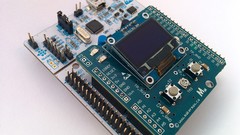Hands on projects with the I2C protocol - Learn by doing
Created By 1
Gain a deep understanding of the I2C and GPIO peripherals with hands on embedded systems projects using STM32
Created By 1
English


Gain a deep understanding of the I2C and GPIO peripherals with hands on embedded systems projects using STM32
Created By 1
English
Section 1 Introduction
I2C Protocol Primer
I2C Connections
Section 3 Introduction
Installing STCubeMx
Setting up the STCubeMx Project to work with MakerMax I2C Shield
Writing the I2C Read Driver for LTC2990
Using the I2C Driver to read the supply voltage from LTC2990 slave
Using I2C Write to configure the LTC2990
Section 4 Introduction
NA
Welcome to this course on embedded systems for STM32: I2C protocol masterclass. The I2C communication protocol is a popular protocol that microcontrollers use to talk to various devices such as EEPROMS and NVRAMs, ADCs and DACs, I/O interfaces for port expansion, and a whole array of different types of sensors. This class goes in-depth into the theory behind the I2C protocol, why it was originally designed, what types of common formats are available, and how to implement I2C communication between a STM32 microcontroller, a LTC2990 current, voltage and temperature sensor and an OLED display.
Who am I?
I’m Akshay, and I’ll be your instructor for this course. I have been fascinated with micro controllers since I was a child, and now I consider it lucky to have it as my profession. I currently write firmware for safety critical systems that go inside electric cars. With my knowledge of embedded systems over the past 10+ years, and working in Silicon Valley, I have gained a unique insight into what the industry needs and what the students are lacking.
Akshay has always had a practical approach to engineering. His quest for Electric Vehicles began in 2008 when he developed a unique dashboard electric scooters that rewards users when they drive electric. In his Masters at University of Toronto he developed a unique way of measuring impedance characteristics of Lithium-ion batteries on-board vehicles that allow for early prediction of battery failures.
He was a core member of the Battery Hardware and Firmware team at Tesla, where he worked on the Model S refresh, Model X and Model 3 vehicles. He is now the Director at MakerMax Inc., that is enabling an ecosystem for mass EV adoption by creating products such as battery analyzers, characterizers and battery management platforms that enable the industry to create high performance and safe Electric Vehicles. He also runs popular online workshops on Battery Technology to reskill professionals and students in this field.